Comparison of Meteorological Drivers of Two Large Coastal Slope-Land Wildfire Events in Croatia and South-East Australia
Abstract
1. Introduction
2. Description of the Study Area and Extreme Fires
2.1. The Split Wildfire in Croatia
2.2. The Forcett–Dunalley Wildfire in Tasmania
3. Materials and Methods
3.1. Numerical Model
3.2. Model Setup
4. Results
4.1. Antecedent Conditions and Fire Danger Rating
4.2. Model Comparison with Measurements
4.3. Comparison of Initial Fire Weather Conditions
4.4. Comparison of Weather Conditions Coinciding with the Most Extreme Fire Behavior
5. Discussion
6. Conclusions
Author Contributions
Funding
Institutional Review Board Statement
Informed Consent Statement
Data Availability Statement
Acknowledgments
Conflicts of Interest
References
- Tomašević, I.Č.; Cheung, K.K.W.; Vučetić, V.; Fox-Hughes, P. Comparison of Wildfire Meteorology and Climate at the Adriatic Coast and Southeast Australia. Atmosphere 2022, 13, 755. [Google Scholar] [CrossRef]
- Vučetić, M.; Vučetić, V.; Španjol, Ž.; Barčić, D.; Rosavec, R.; Mandić, A. Secular variations of monthly severity rating on the Croatian Adriatic coast during the forest fire season. For. Ecol. Manag. 2006, 234 (Suppl. 1), 251. [Google Scholar] [CrossRef]
- Lucas, C.; Hennessy, K.; Mills, G.; Bathols, J. Bushfire Weather in Southeast Australia: Recent Trends and Projected Climate Change Impacts; Consultancy Report Prepared for The Climate Institute of Australia; Bureau of Meteorology Research Centre: Melbourne, Australia, 2007.
- Barešić, D. The Impact of Climate Change on the Potential Risk of Forest Fires in Croatia. Master’s Thesis, Faculty of Science, University of Zagreb, Zagreb, Croatia, 2011. (In Croatian). [Google Scholar]
- Dowdy, A.J. Climatological Variability of Fire Weather in Australia. J. Appl. Meteorol. Climatol. 2018, 57, 221–234. [Google Scholar] [CrossRef]
- Dowdy, A.J.; Pepler, A. Pyroconvection risk in Australia: Climatological changes in atmospheric stability and surface fire weather conditions. Geophys. Res. Lett. 2018, 45, 2005–2013. [Google Scholar] [CrossRef]
- Vučetić, M.; Vučetić, V. Wildfire risk in Croatia using the Canadian Forest Fire Weather Index System. In Proceedings of the 6th International Fire Behavior and Fuels Conference, Marseille, France, 29 April–3 May 2019. [Google Scholar]
- Flannigan, M.D.; Cantin, A.S.; de Groot, W.J.; Wotton, M.; Newbery, A.; Gowman, L.M. Global wildland fire season severity in the 21st century. For. Ecol. Manag. 2013, 294, 54–61. [Google Scholar] [CrossRef]
- IPCC. Climate Change 2021: The Physical Science Basis. In Contribution of Working Group I to the Sixth Assessment Report of the Intergovernmental Panel on Climate Change; Masson-Delmotte, V., Zhai, P., Pirani, A., Connors, S.L., Péan, C., Berger, S., Caud, N., Chen, Y., Goldfarb, L., Gomis, M.I., et al., Eds.; Cambridge University Press: London, UK, 2021. [Google Scholar]
- Čavlina Tomašević, I.; Cheung, K.K.W.; Vučetić, V.; Fox-Hughes, P.; Horvath, K.; Telišman Prtenjak, M.; Beggs, P.J.; Malečić, B.; Milić, V. The 2017 Split wildfire in Croatia: Evolution and the role of meteorological conditions. Nat. Hazards Earth Syst. Sci. 2022, 22, 3143–3165. [Google Scholar] [CrossRef]
- Ndalila, M.N.; Williamson, G.J.; Fox-Hughes, P.; Sharples, J.; Bowman, D.M.J.S. Evolution of an extreme pyrocumulonimbus driven wildfire event in Tasmania, Australia. Nat. Hazards Earth Syst. Sci. 2020, 20, 1497–1511. [Google Scholar] [CrossRef]
- Čavlina Tomašević, I. Analysis of Extreme Fire Weather during Catastrophic Wildfires in Croatia and Australia. Ph.D. Thesis, University of Zagreb, Faculty of Science, Zagreb, Croatia, 2022. Available online: https://urn.nsk.hr/urn:nbn:hr:217:146249 (accessed on 28 April 2023).
- Fox-Hughes, P. Impact of More Frequent Observations on the Understanding of Tasmanian Fire Danger. J. Appl. Meteor. Climatol. 2011, 50, 1617–1626. [Google Scholar] [CrossRef]
- Clarke, H.G.; Lucas, C.; Smith, P.L. Changes in Australian fire weather between 1973 and 2010. Intl. J. Climatol. 2013, 33, 931–944. [Google Scholar] [CrossRef]
- Tomašević, I.; Vučetić, V. Rating the fire season 2013 and comparison with the fire season 2012. Firef. Manag. 2014, 4, 19–35. (In Croatian) [Google Scholar]
- Bakšić, N.; Vučetić, M.; Španjol, Ž. A potential risk of fire on open space in the Republic of Croatia. Firef. Manag. 2015, 5, 30–40. (In Croatian) [Google Scholar]
- Harris, S.; Mills, G.; Brown, T. Variability and drivers of extreme fire weather in fire-prone areas of south-eastern Australia. Intl. J. Wildland Fire 2017, 26, 177–190. [Google Scholar] [CrossRef]
- Turco, M.; Llasat, M.C.; Von Hardenberg, J.; Provenzale, A. Climate change impacts on wildfires in a Mediterranean environment. Clim. Change 2014, 125, 369–380. [Google Scholar] [CrossRef]
- Turco, M.; Rosa-Cánovas, J.J.; Bedia, J.; Jerez, S.; Montávez, J.P.; Llasat, M.C.; Provenzale, A. Exacerbated fires in Mediterranean Europe due to anthropogenic warming projected with nonstationary climate-fire models. Nature Comm. 2018, 9, 3821. [Google Scholar] [CrossRef]
- Dupuy, J.L.; Fargeon, H.; Martin-St Paul, N.; Pimont, F.; Ruffault, J.; Guijarro, M.; Hernando, C.; Madrigal, J.; Fernandes, P. Climate change impact on future wildfire danger and activity in southern Europe: A review. Ann. For. Sci. 2020, 77, 35. [Google Scholar] [CrossRef]
- Clarke, H.; Evans, J.P. Exploring the future change space for fire weather in southeast Australia. Theor. Appl. Climatol. 2019, 136, 513–527. [Google Scholar] [CrossRef]
- Dowdy, A.J.; Ye, H.; Pepler, A.; Thatcher, M.; Osbrough, S.L.; Evans, J.P. Future changes in extreme weather and pyroconvection risk factors for Australian wildfires. Sci. Rep. 2019, 9, 10073. [Google Scholar] [CrossRef]
- Fox-Hughes, P.; Harris, R.M.B.; Lee, G.; Grose, M.R.; Bindoff, N.L. Future fire danger climatology for Tasmania, Australia, using a dynamically downscaled regional climate model. Intl. J. Wildland Fire. 2014, 23, 309–321. [Google Scholar] [CrossRef]
- Mills, G.A.; Pendlebury, S. Processes leading to a severe windshear incident at Hobart Airport. Aust. Meteorol. Mag. 2003, 52, 171–188. [Google Scholar]
- Mills, G.A.; McCaw, L. Atmospheric Stability Environments and Fire Weather in Australia–Extending the Haines Index; CAWCR Technical Report No. 20; Centre for Australian Weather and Climate Research: Melbourne, Australia, 2010.
- Fox-Hughes, P. Springtime fire weather in Tasmania, Australia: Two case studies. Wea. Forecast. 2012, 27, 379–395. [Google Scholar] [CrossRef]
- Jovanović, N.; Župan, R. Analysis of vegetation conditions before and after forest fires in Dalmatia using Sentinel-2 satellite images. Geodetski List. 2017, 71, 233–248. [Google Scholar]
- Marsden-Smedley, J. Tasmanian Wildfires January–February 2013: Forcett-Dunalley, Repulse, Bicheno, Giblin River, Montumana, Molesworth and Gretna; Bushfire Cooperative Research Centre: Melbourne, Australia, 2014. [Google Scholar]
- Ndalila, M.N.; Williamson, G.J.; Bowman, D. Geographic Patterns of Fire Severity Following an Extreme Eucalyptus Forest Fire in Southern Australia: 2013 Forcett-Dunalley Fire. Fire 2018, 1, 40. [Google Scholar] [CrossRef]
- Skamarock, W.C.; Klemp, J.B.; Dudhia, J.; Gill, D.O.; Baker, D.M.; Wang, W.; Powers, J.G. A description of the Advanced Research WRF Version 2; NCAR Tech. Note NCAR/TN-468+STR; National Center for Atmospheric Research: Boulder, CO, USA, 2005; p. 88.
- Wang, W.; Barker, D.; Bray, J.; Bruyère, C.; Duda, M.; Dudhia, J.; Gill, D.; Michalakes, J. Users Guide for the Advanced Research WRF (ARW) Modeling System v4.2; National Center for Atmospheric Research: Boulder, CO, USA, 2007; pp. 1–464.
- Coen, J.L.; Cameron, M.; Michalakes, J.; Patton, E.G.; Riggan, P.J.; Yedinak, K.M. WRF-FIRE: Coupled Weather–Wildland Fire Modelling with the Weather Research and Forecasting Model. J. Appl. Meteorol. Clim. 2013, 52, 16–38. [Google Scholar] [CrossRef]
- Telišman Prtenjak, M.; Viher, M.; Jurković, J. Sea-land breeze development during a summer bora event along the north-eastern Adriatic coast. Quart. J. R. Meteorol. Soc. 2010, 136, 1554–1571. [Google Scholar] [CrossRef]
- Telišman Prtenjak, M.; Horvat, I.; Tomažić, I.; Kvakić, M.; Viher, M.; Grisogono, B. Impact of mesoscale meteorological processes on anomalous radar propagation conditions over the northern Adriatic area. J. Geophys. Res. Atmos. 2015, 120, 8759–8782. [Google Scholar] [CrossRef]
- Nauslar, N.; Abatzoglou, J.; Marsh, P. The 2017 North Bay and Southern California fires: A case study. Fire 2018, 1, 18. [Google Scholar] [CrossRef]
- Brewer, M.J.; Clements, C.B. The 2018 Camp Fire: Meteorological analysis using in situ observations and numerical simulations. Atmosphere 2020, 11, 47. [Google Scholar] [CrossRef]
- Dee, D.; Uppala, S.M.; Simmons, A.; Berrisford, P.; Poli, P.; Kobayashi, S.; Andrae, U.; Balmaseda, M.A.; Balsamo, G.; Bauer, P.; et al. The ERA-Interim reanalysis: Configuration and performance of the data assimilation system. Quart. J. Roy. Meteorol. Soc. 2011, 137, 553–597. [Google Scholar] [CrossRef]
- Tudor, M.; Stanešić, A.; Ivatek-Šahdan, S.; Hrastinski, M.; Odak Plenković, I.; Horvath, K.; Bajić, A.; Kovačić, T. Operational validation and verification of ALADIN forecast in Meteorological and hydrological service of Croatia. Croat. Meteorol. J. 2015, 50, 47–70. [Google Scholar]
- Nakanishi, M.; Niino, H. An improved Mellor-Yamada Level-3 model: Its numerical stability and application to a regional prediction of advection fog. Bound.-Layer Meteorol. 2006, 119, 397–407. [Google Scholar] [CrossRef]
- Mlawer, E.J.; Taubman, S.J.; Brown, P.D.; Iacono, M.J.; Clough, S.A. Radiative transfer for inhomogeneous atmospheres: RRTM, a validated correlated-k model for the longwave. J. Geophys. Res. Atmos. 1997, 102, 16663–16682. [Google Scholar] [CrossRef]
- Dudhia, J. Numerical study of convection observed during the Winter Monsoon Experiment using a mesoscale two-dimensional model. J. Atmos. Sci. 1989, 46, 3077–3107. [Google Scholar] [CrossRef]
- Morrison, H.; Thompson, G.; Tatarskii, V. Impact of cloud microphysics on the development of trailing stratiform precipitation in a simulated squall line: Comparison of one- and two-moment schemes. Mon. Weather Rev. 2009, 137, 991–1007. [Google Scholar] [CrossRef]
- Kain, J.S.; Kain, J. The Kain—Fritsch convective parameterization: An update. J. Appl. Meteorol. 2004, 43, 170–181. [Google Scholar] [CrossRef]
- Broxton, P.D.; Zeng, X.; Sulla-Menashe, D.; Troch, P.A. A global land cover climatology using MODIS data. J. Appl. Meteor. Climatol. 2014, 53, 1593–1605. [Google Scholar] [CrossRef]
- Pielke, R.A. Mesoscale Meteorological Modeling; Academic Press: San Diego, CA, USA, 2002. [Google Scholar]
- BoM (Bureau of Meteorology). Tasmanian Bushfires Inquiry; Bureau of Meteorology: Hobart, TAS, Australia, 2013.
- Van Wagner, C.E.; Pickett, T.L. Equations and Fortran Program for the Canadian Forest Fire Weather Index System; Forestry Technical Report 33; Canadian Forestry Service, Government of Canada: Ottawa, ON, Canada, 1985.
- McArthur, A.G. Fire Behaviour in Eucalypt Forests, Leaflet Number 107; Commonwealth of Australia Department of National Development, Forestry and Timber Bureau: Canberra, Australia, 1967.
- Luke, R.; McArthur, A. Bushfires in Australia; Australian Government Publishing Service: Canberra, Australia, 1978.
- Ferina, J.; Vučetić, V. Rating the Fire Season 2017; Croatian Meteorological and Hydrological Service: Zagreb, Croatia, 2018. (In Croatian)
- ALADIN International Team. In The ALADIN Project: Mesoscale Modelling Seen as a Basic Tool for Weather Forecasting and Atmospheric Research; World Meteorological Organization (WMO) Bulletin: Geneva, Switzerland, 1997; Volume 46, pp. 317–324.
- Su, C.-H.; Eizenberg, N.; Steinle, P.; Jakob, D.; Fox-Hughes, P.; White, C.J.; Rennie, S.; Franklin, C.; Dharssi, I.; Zhu, H. BARRA v1.0: The Bureau of Meteorology Atmospheric high-resolution Regional Reanalysis for Australia. Geosci. Model Dev. 2019, 12, 2049–2068. [Google Scholar] [CrossRef]
- Tudor, M.; Ivatek-Šahdan, S.; Stanešić, A.; Horvath, K.; Bajić, A. Forecasting weather in Croatia using ALADIN numerical weather prediction model. In Climate Change and Regional/Local Responses; Zhang, Y., Ray, P., Eds.; IntechOpen: Rijeka, Croatia, 2013; pp. 59–88. [Google Scholar] [CrossRef]
- Tudor, M. Improvements in the operational forecast of dentrimental weather conditions in the numerical limited area model ALADIN. Ph.D. Thesis, Faculty of Science, University of Zagreb, Zagreb, Croatia, 2018. [Google Scholar]
- Stanešić, A.; Horvath, K.; Keresturi, E. Comparison of NMC and Ensemble-Based Climatological Background-Error Covariances in an Operational Limited-Area Data Assimilation System. Atmosphere 2019, 10, 570. [Google Scholar] [CrossRef]
- Su, C.-H.; Eizenberg, N.; Jakob, D.; Fox-Hughes, P.; Steinle, P.; White, C.J.; Franklin, C. BARRA v1.0: Kilometre-scale downscaling of an Australian regional atmospheric reanalysis over four midlatitude domains. Geosci. Model Dev. 2021, 14, 4357–4378. [Google Scholar] [CrossRef]
- Fromm, M.; Tupper, A.; Rosenfeld, D.; Servranck, R.; McRae, R. Violent pyro-convective storm devastates Australia’s capital and pollutes the stratosphere. Geophys. Res. Lett. 2006, 33, L05815. [Google Scholar] [CrossRef]
- Cruz, M.G.; Sullivan, A.L.; Gould, J.S.; Sims, N.C.; Bannister, A.J.; Hollis, J.J.; Hurley, R.J. Anatomy of a catastrophic wildfire: The Black Saturday Kilmore East fire in Victoria, Australia. For. Ecol. Manag. 2012, 284, 269–285. [Google Scholar] [CrossRef]
- Field, R.D.; Luo, M.; Fromm, M.; Voulgarakis, A.; Mangeon, S.; Worden, J. Simulating the Black Saturday 2009 smoke plume with an interactive composition-climate model: Sensitivity to emissions amount, timing, and injection height. J. Geophys. Res. Atmos. 2016, 121, 4296–4316. [Google Scholar] [CrossRef] [PubMed]
- Peterson, D.A.; Campbell, J.R.; Hyer, E.J.; Fromm, M.D.; Kablick, P., III; Cossuth, J.H.; Deland, M.T. Wildfire-driven thunderstorms cause a volcano-like stratospheric injection of smoke. Npj Clim. Atmos. Sci. 2018, 1, 30. [Google Scholar] [CrossRef] [PubMed]
- Sharples, J.J.; Cary, G.J.; Fox-Hughes, P.; Mooney, S.; Evans, J.P.; Fletcher, M.S.; Fromm, M.; Grierson, P.F.; McRae, R.; Baker, P. Natural hazards in Australia: Extreme bushfire. Clim. Chang. 2016, 139, 85–99. [Google Scholar] [CrossRef]
- Mifka, B.; Vučetić, V. Weather analysis during extreme forest fire on island of Brač from 14 to 17 July 2011. Vatrog. I Upravlj. Požarima 2012, 1, 13–25. (In Croatian) [Google Scholar]
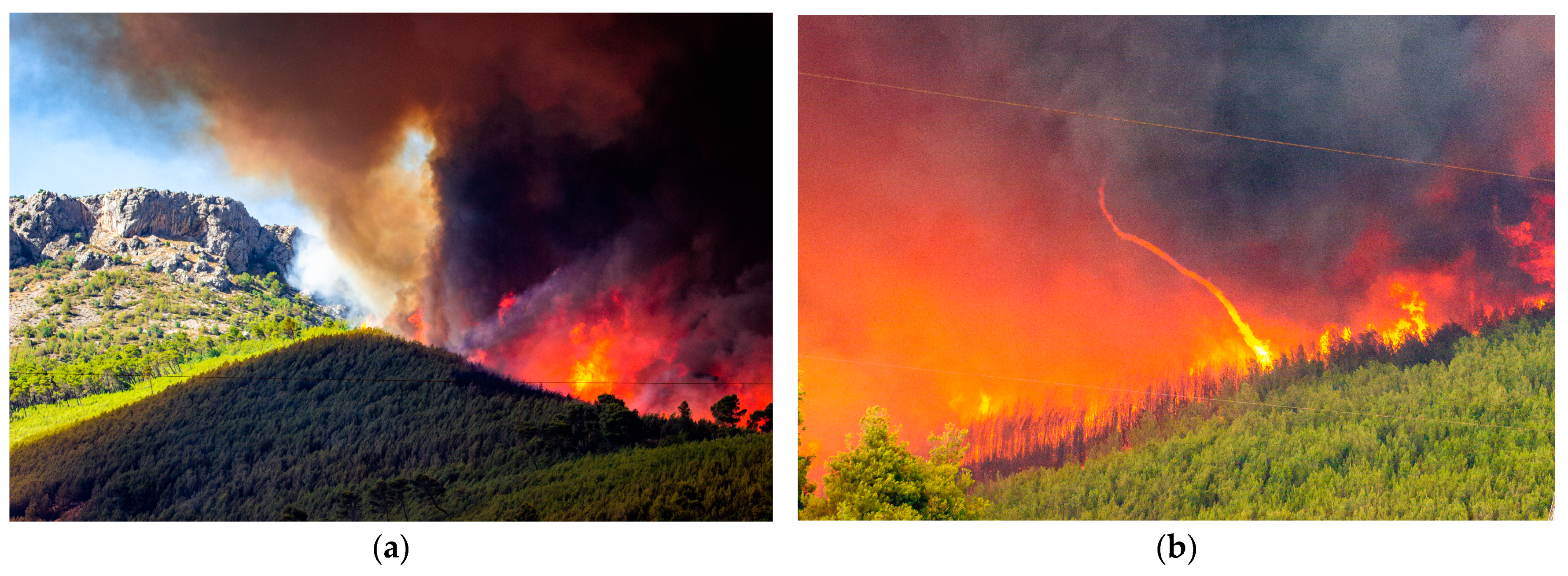
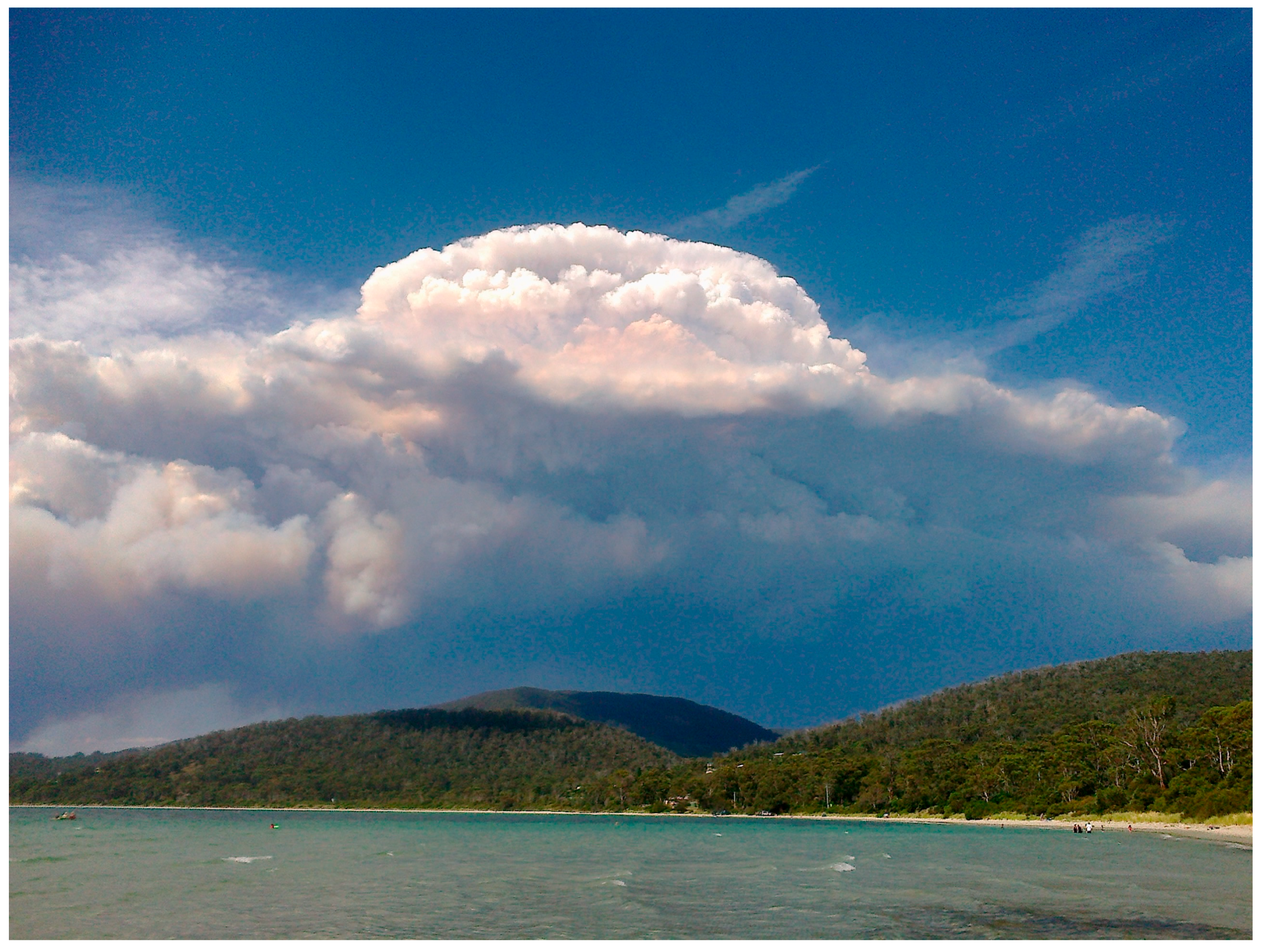
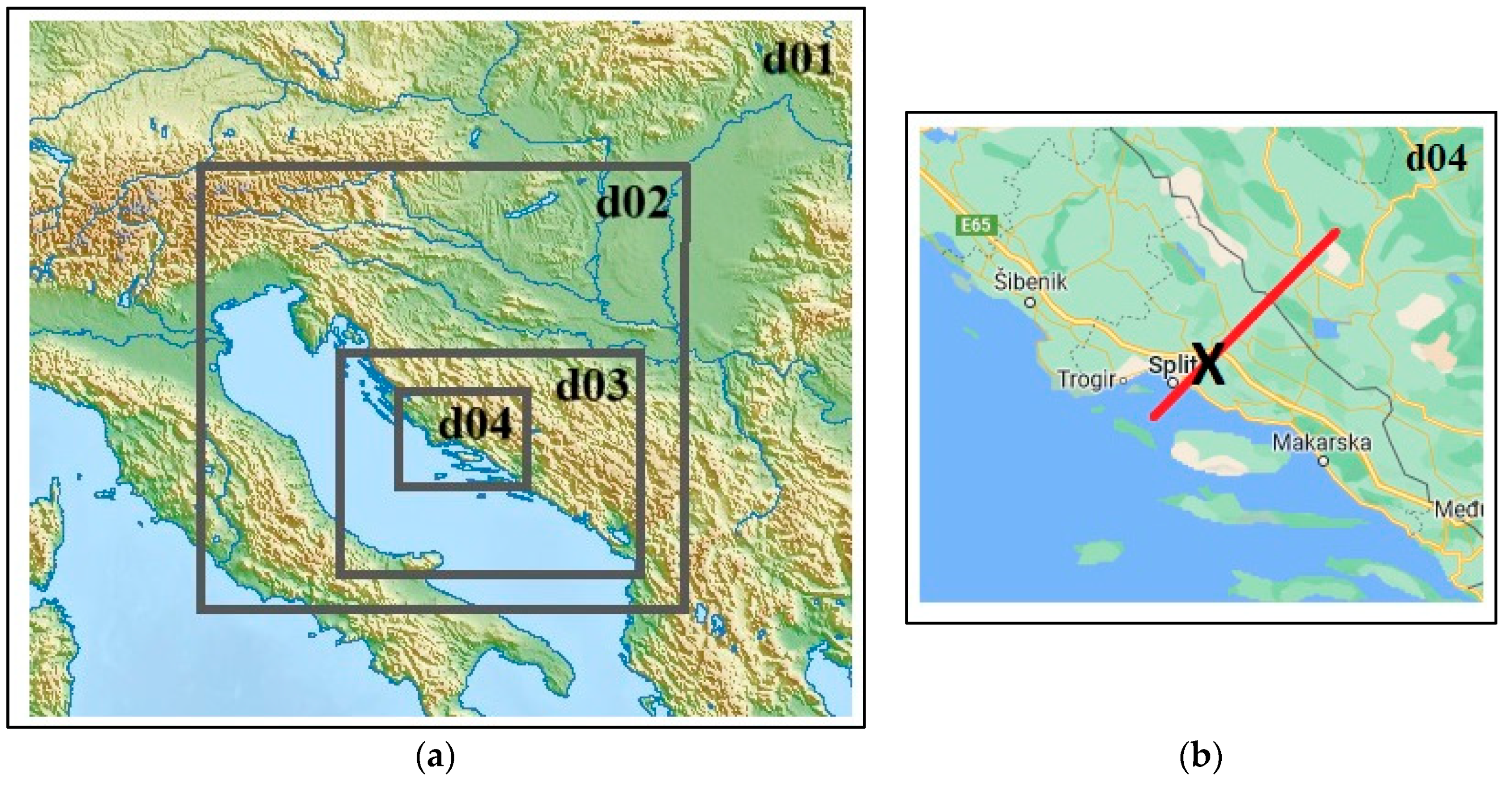

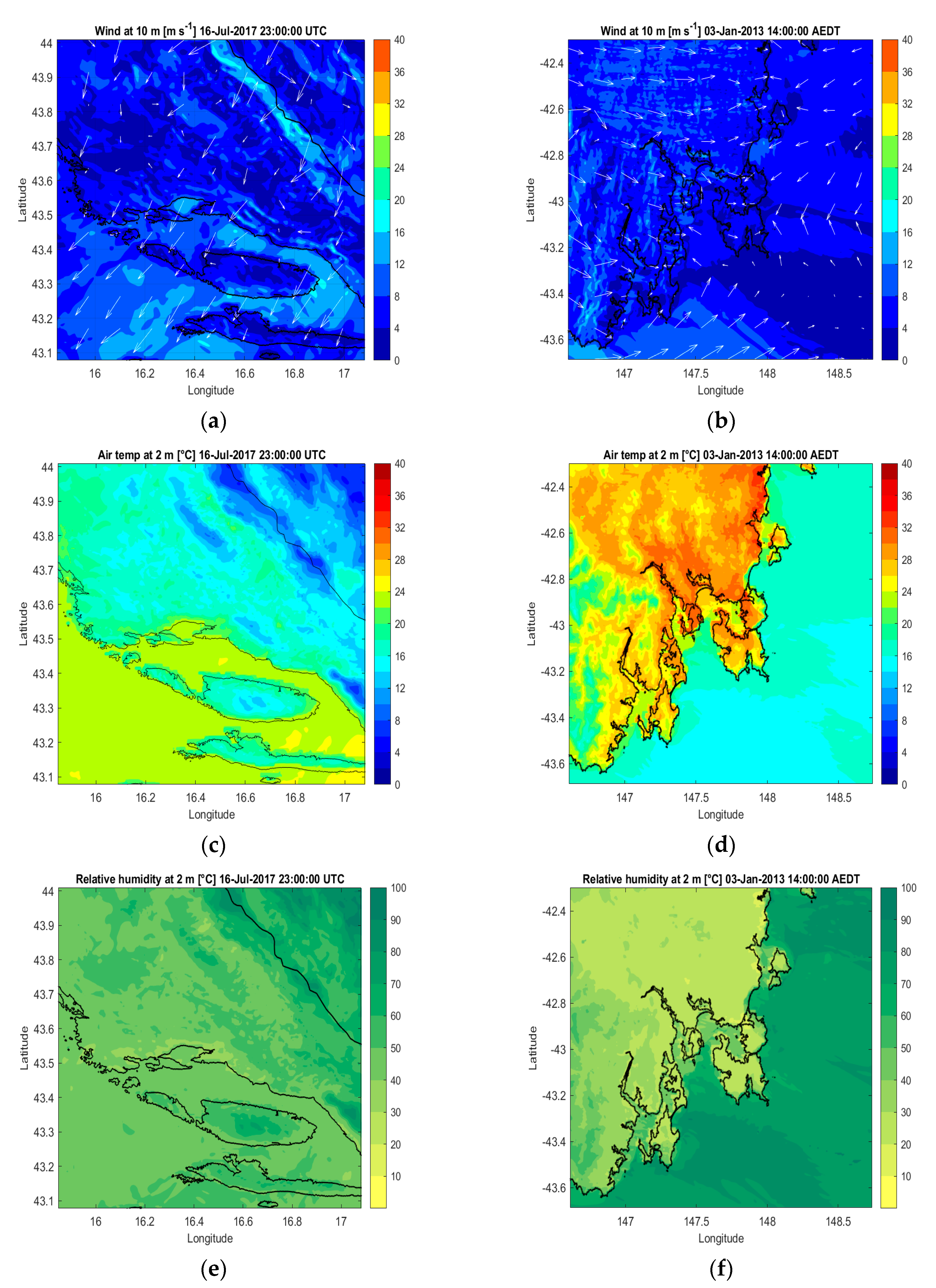
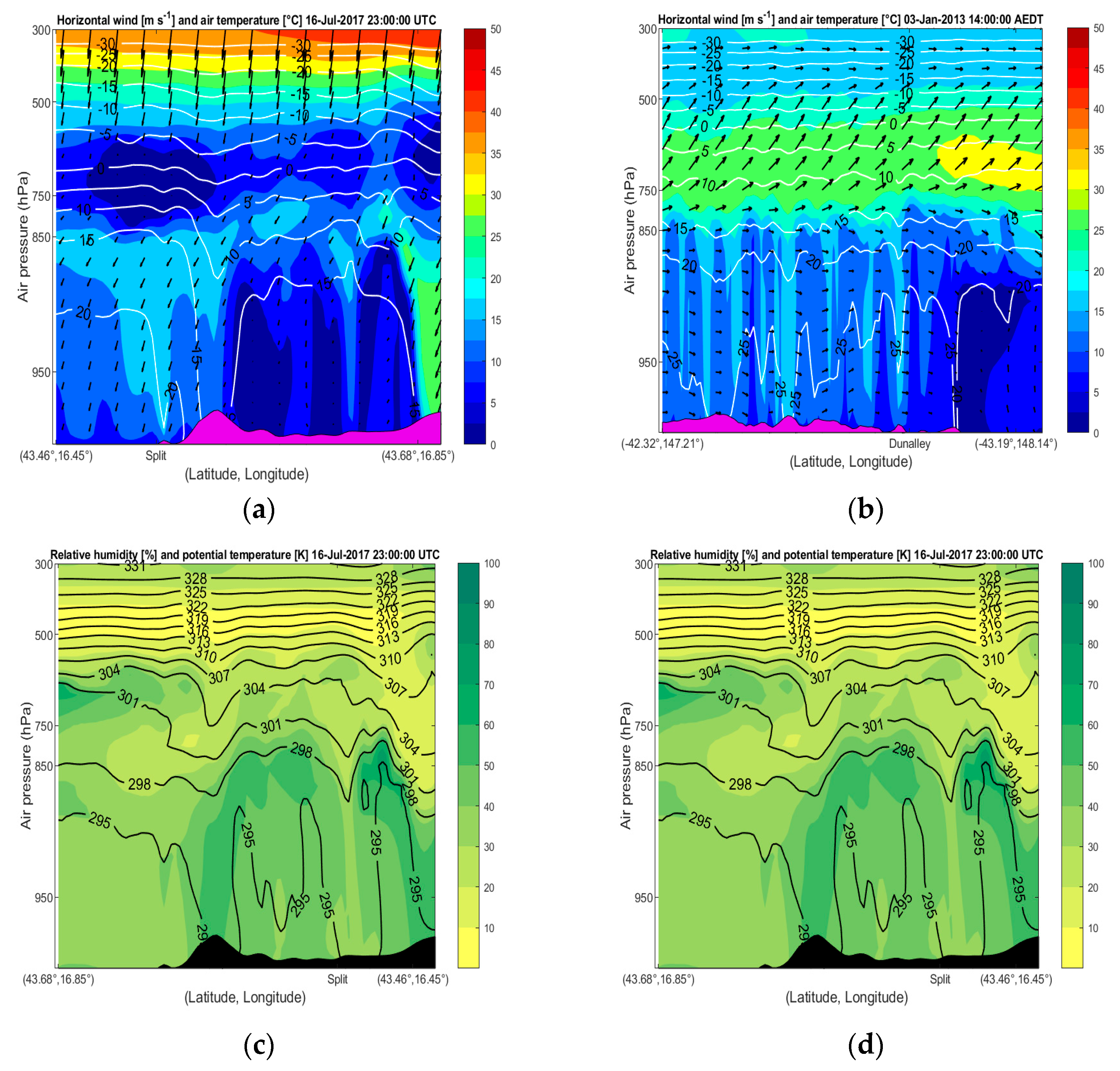

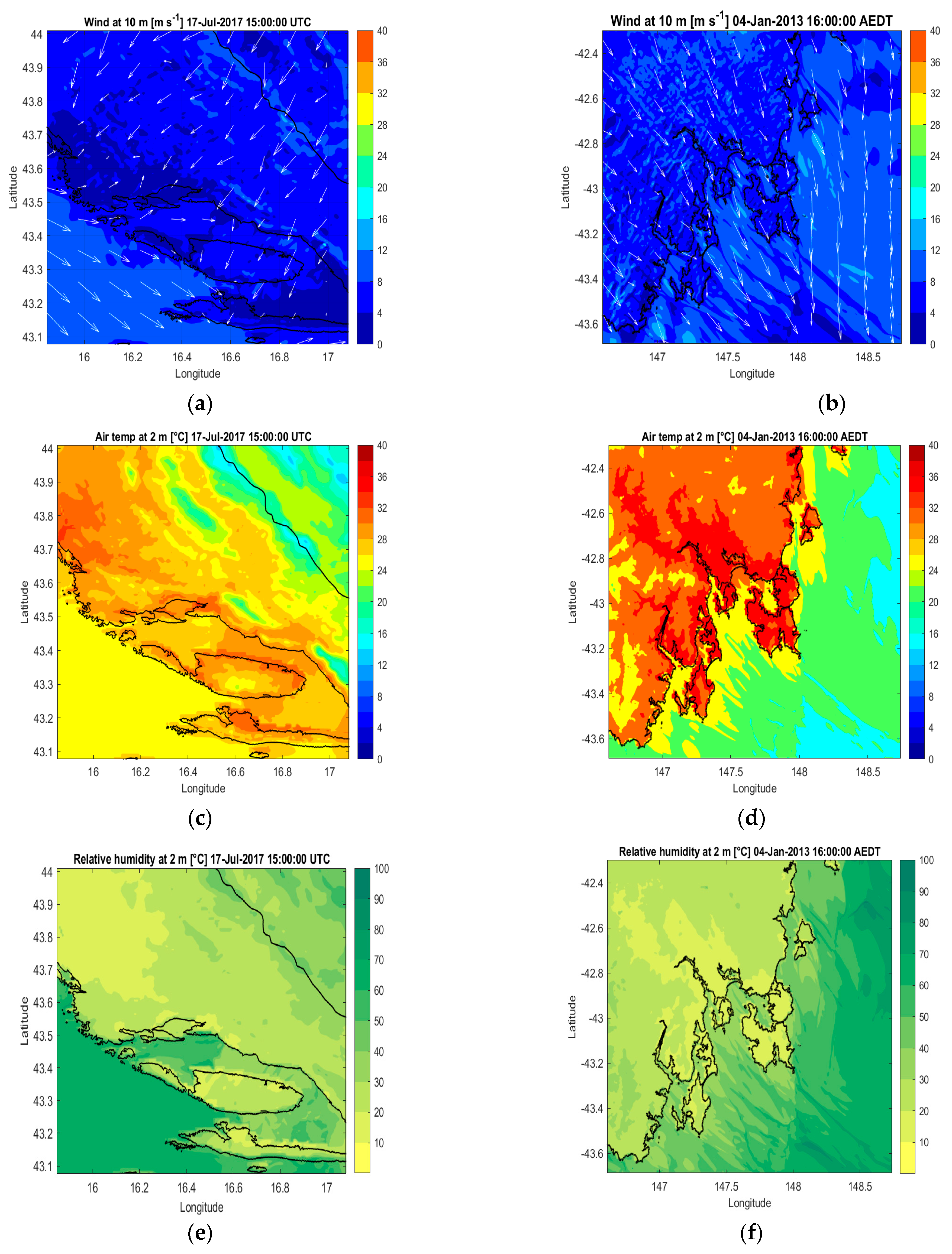
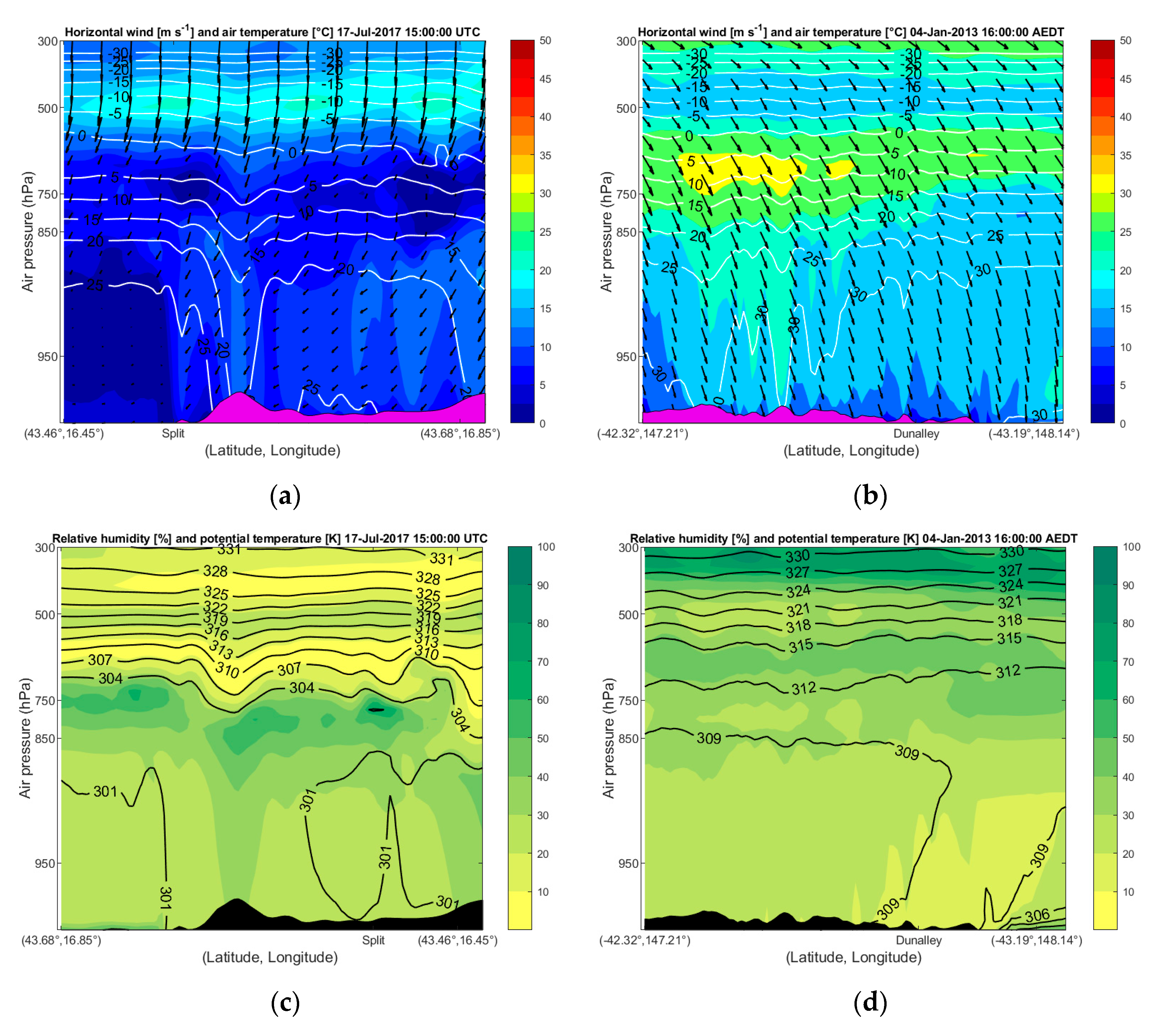
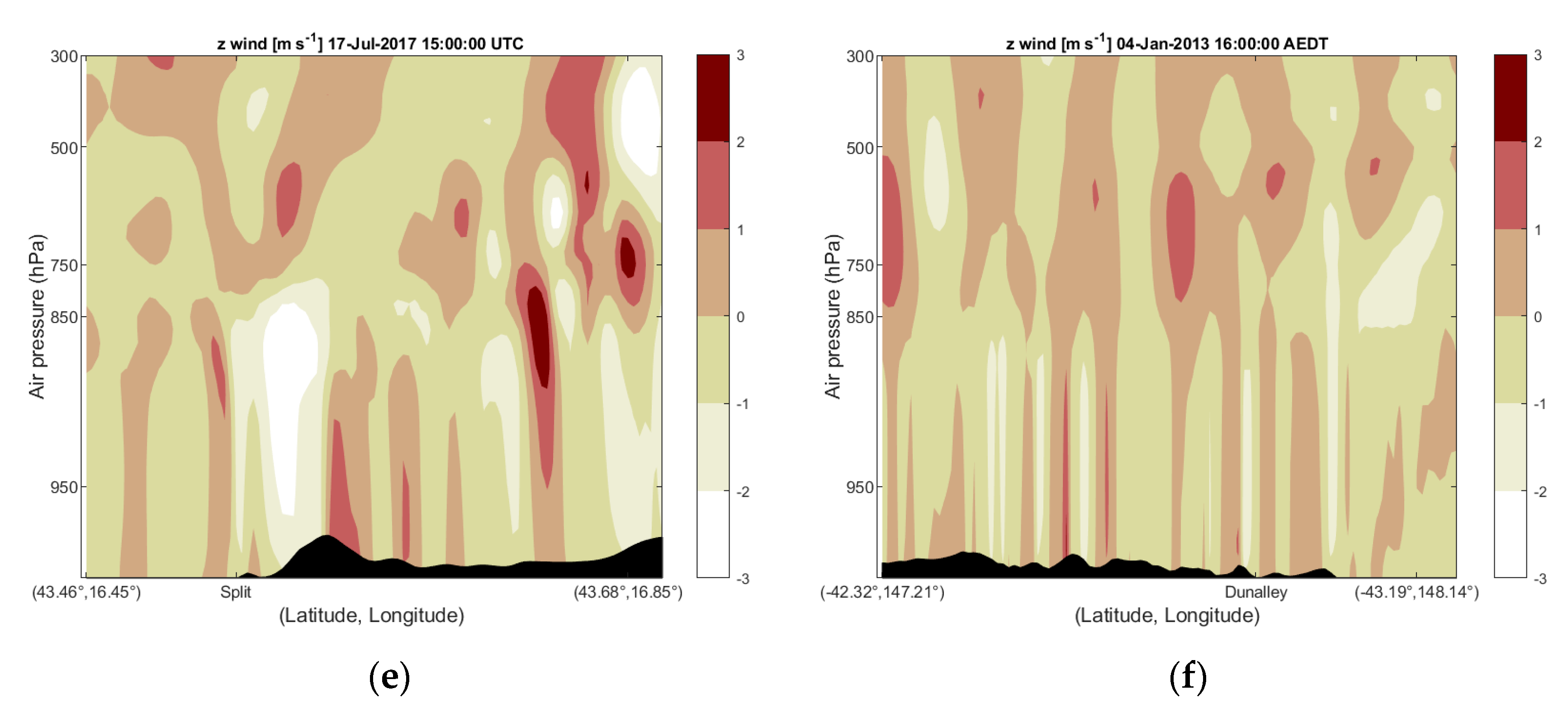
| WRF Simulation Domain and Resolution | Number of Grid Points (West-East × South-North × Hybrid Levels) and Size of Domain | |
|---|---|---|
| Croatian Case Study | Australian Case Study | |
| d01 (9.0 km) | 110 × 110 × 66 990 km × 990 km | 434 × 392 × 66 3906 km × 3528 km |
| d02 (4.5 km) | 151 × 153 × 66 679.5 km × 688.5 km | 457 × 423 × 66 2056 km × 1903.5 km |
| d03 (1.5 km) | 244 × 223 × 66 366 km × 334.5 km | 352 × 331 × 66 528 km × 496.5 km |
| d04 (0.5 km) | 196 × 202 × 66 98 km × 101 km | 346 × 310 × 66 173 km × 155 km |
Disclaimer/Publisher’s Note: The statements, opinions and data contained in all publications are solely those of the individual author(s) and contributor(s) and not of MDPI and/or the editor(s). MDPI and/or the editor(s) disclaim responsibility for any injury to people or property resulting from any ideas, methods, instructions or products referred to in the content. |
© 2023 by the authors. Licensee MDPI, Basel, Switzerland. This article is an open access article distributed under the terms and conditions of the Creative Commons Attribution (CC BY) license (https://creativecommons.org/licenses/by/4.0/).
Share and Cite
Čavlina Tomašević, I.; Vučetić, V.; Cheung, K.K.W.; Fox-Hughes, P.; Beggs, P.J.; Telišman Prtenjak, M.; Malečić, B. Comparison of Meteorological Drivers of Two Large Coastal Slope-Land Wildfire Events in Croatia and South-East Australia. Atmosphere 2023, 14, 1076. https://doi.org/10.3390/atmos14071076
Čavlina Tomašević I, Vučetić V, Cheung KKW, Fox-Hughes P, Beggs PJ, Telišman Prtenjak M, Malečić B. Comparison of Meteorological Drivers of Two Large Coastal Slope-Land Wildfire Events in Croatia and South-East Australia. Atmosphere. 2023; 14(7):1076. https://doi.org/10.3390/atmos14071076
Chicago/Turabian StyleČavlina Tomašević, Ivana, Višnjica Vučetić, Kevin K. W. Cheung, Paul Fox-Hughes, Paul J. Beggs, Maja Telišman Prtenjak, and Barbara Malečić. 2023. "Comparison of Meteorological Drivers of Two Large Coastal Slope-Land Wildfire Events in Croatia and South-East Australia" Atmosphere 14, no. 7: 1076. https://doi.org/10.3390/atmos14071076
APA StyleČavlina Tomašević, I., Vučetić, V., Cheung, K. K. W., Fox-Hughes, P., Beggs, P. J., Telišman Prtenjak, M., & Malečić, B. (2023). Comparison of Meteorological Drivers of Two Large Coastal Slope-Land Wildfire Events in Croatia and South-East Australia. Atmosphere, 14(7), 1076. https://doi.org/10.3390/atmos14071076








